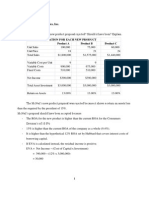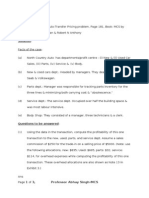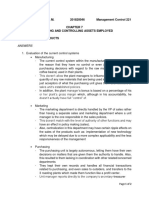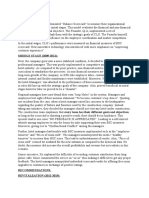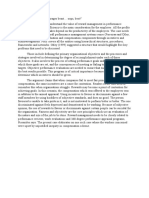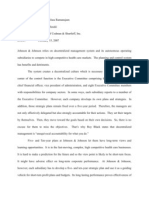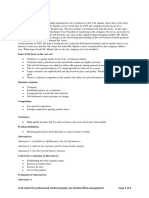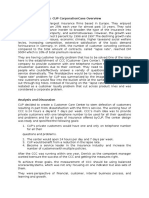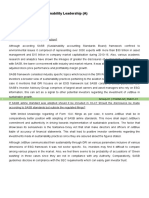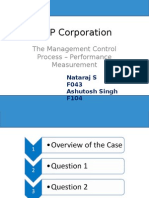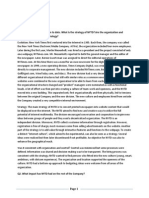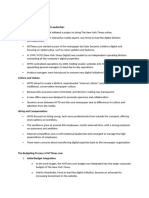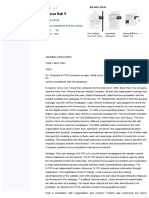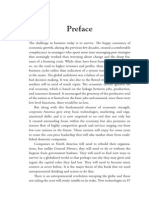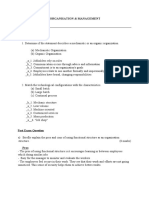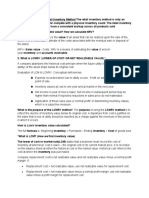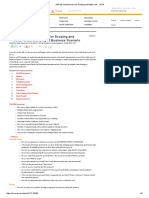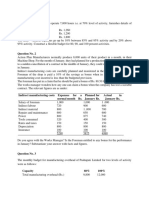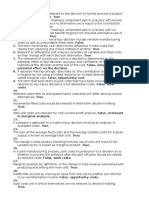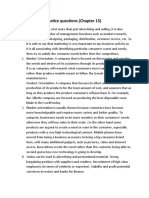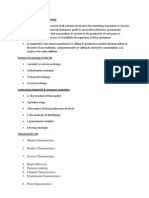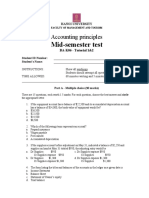Case 9 1
Case 9 1
Uploaded by
Jessica TjanCopyright:
Available Formats
Case 9 1
Case 9 1
Uploaded by
Jessica TjanCopyright
Available Formats
Share this document
Did you find this document useful?
Is this content inappropriate?
Copyright:
Available Formats
Case 9 1
Case 9 1
Uploaded by
Jessica TjanCopyright:
Available Formats
Q1. Describe NYTDs evolution to date. What is the strategy of NYTD?
Are the organization and control consistent with the strategy? Evolution: New York Times first ventured into the Internet in 1995. Back then, the company was called the New York Times Electronic Media Company. At first, the organization included four more employees. Later during the first year, Martin Niesenholtz was hired as a president and the project consisted of only one webpage; NYTimes.com. Mr. Niesenholtz reported to both the general manager and the editor of the newspaper. Later, Bernie Gwertzman was assigned to direct the editorial operations of NYTimes.com. At this time there was a need for an own newsroom for the digital version of the newspaper. In 1999, a new operating division, Times Company Digital, was created, which reported directly to corporate management. The new division included NYTimes.com, Boston.com, NYToday.com, GolfDigest.com, WineToday.com, and Abuzz. The new division had a very decentralized structure and different organizational structures but still with similar roles as a common newspaper. The different websites were combined in the new organization to be able to learn from eachother. However, in 2000, the organizational structure changed and product managers were nominated as well as functional heads. A lot of effort was then put into creating a culture of team-work and openness, and the NYTD moved into a new building. This separated unit, first organizationally and then physically, led to tensions between the original Company and the new division. The new culture and employees hired from outside the Company created a very competitive internal environment. Strategy: The main strategy of NYTD is to convert printed newspapers into website content that would be displayed over the internet. The NYTD aimed to find new and creative ways to utilize the full potential of internet multimedia. The division encouraged conversation and cooperation to inspire new ideas between groups of people and they used a decentralized organization. The NYTD is an independent division. Moreover, NYTD collects customer information through registration. However, registration is free of charge; most revenues come from selling advertisements on the website. Another part of the strategy is to add value through interactive features and functions to the webpage. To create a distinct Internet culture, which aimed to be experimental, can also be seen as a strategy. Several ideas were realized but then later discontinued if not profitable. An objective for NYTD was also to enhance the geographical reach. Was it consistent with organization and control? Control was minimized but some processes were defined. Information was shared and decision-making was to be transparent. The hiring process was consistent with the strategy; NYTD wanted to find persons who fitted into the new culture (young, smart, ambitious, with dotcom experience). The organization and location supported the openness of the culture. NYTD had a bottom-up approach to budgeting; ideas were welcome from all areas of the organization. Q2. What impact has NYTD had on the rest of the Company? In the beginning, NYTD was considered a credible part of the corporation. However, in time NYTD created a lot of tensions with the original Company. NYTD broke down the Chinese Wall that existed between the editorial and business operations in the original Company; they encouraged collaboration
Page 1
and communication. Concerning advertising sales, the newspaper sales force was unwilling to share their key customers. Moreover, staff feared that the online version would decrease subscription sales. It did not; it even increased the number of subscriptions and became a complementary asset instead of a competitive. Because of this, NYTD considered its branch to have a positive impact on the Company. However, tension was also due to the fact that NYTD was allowed to stay in business even though it lost money several years in a row. Q3. How does the way NYTD is managed compare to the way a venture capital firm manages a startup? What insight, if any, do you draw from this comparison? NYTD can be compared to a venture capital as a lot of money has been invested in the beginning, this can be described as organic growth. However, contrary to the venture capital, there has been no real return on investment. Q4. What impact do internal perceptions of NYTDs performance have on its operations? In NYTD, the employees are a priority; all the ideas are coming from them. As said before, there is a very tough selection; they are using an external and internal hiring system. This organization allows them to work in a fully creative atmosphere. Q5. Would you change in NYTDs existing organizational structure? According to themselves, the NYTD division works pretty well, indeed they have a good organizational structure, they do not really need change. However we can make some suggestions, a better collaboration between NYTD and the company would reduce the rivalry. The use of responsibility centers, increased measurement of financial performance could be a good solution as well as to increase the number of sources of profit.
Page 2
You might also like
- Enager Industries, Inc.Document6 pagesEnager Industries, Inc.luckyladdy100% (11)
- Pioneer PetroleumDocument6 pagesPioneer PetroleumKristine IbascoNo ratings yet
- Case North Country AutoDocument3 pagesCase North Country AutoAnanda Agustin Fitriana100% (2)
- China Lodging Group.Document5 pagesChina Lodging Group.Kumar Patel0% (1)
- Global InvestorsDocument2 pagesGlobal InvestorsArtikaIndahsari100% (1)
- New York TimesDocument10 pagesNew York Timesarvind3041990No ratings yet
- New Jersey InsuranceDocument2 pagesNew Jersey Insurancerksp9999950% (2)
- Grand Jean CompanyDocument6 pagesGrand Jean CompanyAdi AdiadiNo ratings yet
- AnswersDocument1 pageAnswersChetan AdsulNo ratings yet
- Birch Paper CompanyDocument12 pagesBirch Paper CompanyChristina AgustinNo ratings yet
- MGT 221 Case 7-4 Aloha Products - DIMMontesDocument2 pagesMGT 221 Case 7-4 Aloha Products - DIMMontesDenisse MontesNo ratings yet
- This Study Resource Was: AnswerDocument2 pagesThis Study Resource Was: Answerteme beya100% (3)
- 420 Dominion PresentationDocument17 pages420 Dominion PresentationPingkan TaraditaNo ratings yet
- KASUS CUP CorporationDocument7 pagesKASUS CUP CorporationNia Azura SariNo ratings yet
- Enager Industries3Document5 pagesEnager Industries3pratheek30100% (1)
- China LodgingsDocument2 pagesChina LodgingsMaryam ZafarNo ratings yet
- Pom Asychronous 2Document1 pagePom Asychronous 2B V Avinash Chowdary 2027931No ratings yet
- Codman & Shurtleff CaseDocument3 pagesCodman & Shurtleff CaseElom Katako33% (3)
- CUP CorporationDocument3 pagesCUP CorporationMuhammad KamilNo ratings yet
- Tips For The Emerson Electric CaseDocument3 pagesTips For The Emerson Electric CaseCahyo Priyatno0% (1)
- Solved Case StudiesDocument4 pagesSolved Case StudiesAlimm De Ibrahm100% (3)
- CHENG V GENATODocument2 pagesCHENG V GENATOLaurena ReblandoNo ratings yet
- CH 10 Analyzing Financial Performance ReportsDocument21 pagesCH 10 Analyzing Financial Performance ReportsKentia Pexi100% (1)
- Whiz Calculator CompanyDocument18 pagesWhiz Calculator CompanyAsibur Rahman100% (1)
- Case Analysis New York Times - Gabungan Semua - FixxxxxxxxxDocument18 pagesCase Analysis New York Times - Gabungan Semua - FixxxxxxxxxGlenius Budiman100% (3)
- CUP CorporationDocument11 pagesCUP CorporationanggaNo ratings yet
- Jane Belinda Saranga - CASE 1-3 Xerox CorporationDocument2 pagesJane Belinda Saranga - CASE 1-3 Xerox CorporationJane Belinda SarangaNo ratings yet
- Grand Jeans Case (Assign 2)Document5 pagesGrand Jeans Case (Assign 2)arn01dNo ratings yet
- North Country Auto, IncDocument2 pagesNorth Country Auto, IncHafsyah MahmudahNo ratings yet
- Vershire Case Analysis - MCSDocument13 pagesVershire Case Analysis - MCSMuhammad Zakky AlifNo ratings yet
- Case 1-3 XEROX - Mardiyah Isma Hidayati - 1101002026Document4 pagesCase 1-3 XEROX - Mardiyah Isma Hidayati - 1101002026Mardiyah Isma HidayatiNo ratings yet
- Hasbro InteractiveDocument2 pagesHasbro InteractiveSandro McTavishNo ratings yet
- HomeWork MCS-Nurul Sari (1101002048) - Case 5.1 5.4Document5 pagesHomeWork MCS-Nurul Sari (1101002048) - Case 5.1 5.4Nurul SariNo ratings yet
- Jawaban Grand JeanDocument7 pagesJawaban Grand JeanSariIsmanengsihNo ratings yet
- Jane Belinda Saranga - CASE 2.1-2.3Document5 pagesJane Belinda Saranga - CASE 2.1-2.3Jane Belinda SarangaNo ratings yet
- Jetblue: Relevant Sustainability Leadership (A) : Situational AnalysisDocument1 pageJetblue: Relevant Sustainability Leadership (A) : Situational AnalysisShivani KarkeraNo ratings yet
- Case Berkshire Industries PLC 1Document2 pagesCase Berkshire Industries PLC 1maastrichtpie0% (2)
- Xerox Case StudyDocument19 pagesXerox Case StudyPrachi Jain100% (2)
- Case 12-4 Wayside Inns, Inc.: Department of Management and Engineering SE-581 83 Linköping WWW - Liu.se/iei 1Document2 pagesCase 12-4 Wayside Inns, Inc.: Department of Management and Engineering SE-581 83 Linköping WWW - Liu.se/iei 1Desti SawamuraNo ratings yet
- BIRCH Paper Company SolutionDocument4 pagesBIRCH Paper Company Solutionhssh8No ratings yet
- Case 5-1 MCSDocument3 pagesCase 5-1 MCSNajla Masthura100% (1)
- Tugas Financial Planning and Analysis The Master Budget (Irga Ayudias Tantri - 12030124100011)Document11 pagesTugas Financial Planning and Analysis The Master Budget (Irga Ayudias Tantri - 12030124100011)irga ayudiasNo ratings yet
- Case 1 XeroxDocument4 pagesCase 1 Xeroxalanz123No ratings yet
- Case19-4 Landau CompanyDocument1 pageCase19-4 Landau Companysaberrz0% (1)
- MCS BudgetingDocument14 pagesMCS BudgetinghadapadNo ratings yet
- Empire Glass Company (A) New LatestDocument18 pagesEmpire Glass Company (A) New LatestSiti Fatimah100% (2)
- Case Study: Ch. 5 North Country Auto, Inc STD.: Mba Sem 4Document16 pagesCase Study: Ch. 5 North Country Auto, Inc STD.: Mba Sem 4Sejal V.PrajapatiNo ratings yet
- HRP Final PPT Seimens Case StudyDocument17 pagesHRP Final PPT Seimens Case StudyRohitNo ratings yet
- NYTDigitalDocument21 pagesNYTDigitalRuchi SainiNo ratings yet
- Cup CorporationDocument17 pagesCup Corporationandri100% (1)
- New Jersey Insurance CompanyDocument13 pagesNew Jersey Insurance CompanyParth V. PurohitNo ratings yet
- Bsz263432882inh PDFDocument4 pagesBsz263432882inh PDFMarsiniNo ratings yet
- Case Study On Solartronics, IncDocument3 pagesCase Study On Solartronics, IncSrishti Wadhwa100% (2)
- A Case Presentation On New York TimesDocument25 pagesA Case Presentation On New York TimesAnkit MehtaNo ratings yet
- Jawaban Kasus Bab 9Document15 pagesJawaban Kasus Bab 9Sabrina Bella86% (7)
- MCS PresentationDocument12 pagesMCS Presentationrohitzinzala2001No ratings yet
- (PDF) Jawaban Kasus Bab 9Document26 pages(PDF) Jawaban Kasus Bab 9Shinning Nunaa45No ratings yet
- How To Future Proof Your OrganizationDocument14 pagesHow To Future Proof Your OrganizationChanthuruNo ratings yet
- Answer 6Document3 pagesAnswer 6pivifot869No ratings yet
- Intrapreneurship Article With QsDocument5 pagesIntrapreneurship Article With QsMikhaela EscubilNo ratings yet
- Blawatt Chap OneDocument26 pagesBlawatt Chap OneMomentum PressNo ratings yet
- 43 Nesta Winning Together Guidestartupcollab PDFDocument49 pages43 Nesta Winning Together Guidestartupcollab PDFseti2016No ratings yet
- SM Case Study IBMDocument4 pagesSM Case Study IBMSiddhi GodeNo ratings yet
- Case StudyDocument42 pagesCase StudyHarshadaNo ratings yet
- L&TDocument16 pagesL&Ttasneem subhanNo ratings yet
- Gillete Shave India MovementDocument1 pageGillete Shave India MovementlavinaNo ratings yet
- Tutorial - 7Document5 pagesTutorial - 7KEL VIN LAMNo ratings yet
- Bill PDFDocument1 pageBill PDFrezolfNo ratings yet
- Act CH 9 QuizDocument5 pagesAct CH 9 QuizLamia AkterNo ratings yet
- SAP SD Questionnaire For Scoping and Better Und..Document9 pagesSAP SD Questionnaire For Scoping and Better Und..kalkikali100% (2)
- Prepaid Order Amount Rs.1199.00: Retail/Tax Invoice/Cash Memorandum 0riginal/duplicate/ TriplicateDocument1 pagePrepaid Order Amount Rs.1199.00: Retail/Tax Invoice/Cash Memorandum 0riginal/duplicate/ TriplicateShyam GokaniNo ratings yet
- Inv 00707Document4 pagesInv 00707AKSHAYNo ratings yet
- Tax: Classification of Individual Taxpayers Income Tax For Individual TaxpayersDocument20 pagesTax: Classification of Individual Taxpayers Income Tax For Individual TaxpayersKezia SantosidadNo ratings yet
- Budget Numerical PDFDocument5 pagesBudget Numerical PDFDilip BhusalNo ratings yet
- Answer Key Relevant CostingDocument6 pagesAnswer Key Relevant CostingMc Bryan BarlizoNo ratings yet
- School - Income StatementDocument23 pagesSchool - Income StatementScribdTranslationsNo ratings yet
- AS Level Exam Practice Questions-Chapter 16Document3 pagesAS Level Exam Practice Questions-Chapter 16Velile KonaNo ratings yet
- Basic Concepts of Excise TaxDocument13 pagesBasic Concepts of Excise Taxk gowtham kumar100% (1)
- Types of Distribution ChannelsDocument4 pagesTypes of Distribution ChannelsMoisés MancillaNo ratings yet
- Strategic PlanDocument8 pagesStrategic PlanMehwish PervaizNo ratings yet
- 3.0 Short Term Decision MakingDocument58 pages3.0 Short Term Decision Makingzarif nezuko100% (1)
- TT09 CVPDocument10 pagesTT09 CVPanhhanna102No ratings yet
- Fdocuments - in Somany Final PRJCTDocument91 pagesFdocuments - in Somany Final PRJCTAryan KumarNo ratings yet
- Definition of Industrial MarketingDocument18 pagesDefinition of Industrial Marketingkartheek_aldi100% (1)
- Unit 3: DR Saad Bin AzharDocument25 pagesUnit 3: DR Saad Bin AzharHarsh Malhotra JiNo ratings yet
- Obstacles To Coordination in A Supply ChainDocument7 pagesObstacles To Coordination in A Supply Chainphuongvy48k25.5No ratings yet
- Emad Ali-CvDocument6 pagesEmad Ali-Cveman211mustafababikerNo ratings yet
- (123doc) - Tai-Lieu-Accounting-Principles-Mid-Semester-Test PDFDocument4 pages(123doc) - Tai-Lieu-Accounting-Principles-Mid-Semester-Test PDFTrung HậuNo ratings yet
- OD124905783016809000Document3 pagesOD124905783016809000rupendrathawaitNo ratings yet
- Chapter 3 Introduction To Business TaxationDocument25 pagesChapter 3 Introduction To Business TaxationCathy Marie Angela ArellanoNo ratings yet
